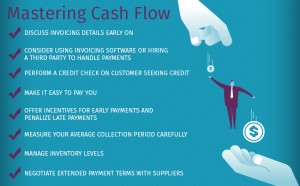
jarmoluk / Pixabay
Agility is often characterized as the ability to think, understand and move quickly and easily. Nimble. Alert. Graceful. Swift.
Stability is often characterized as the ability to withstand force or stress without being distorted, dislodged or damaged. Firm. Sound. Strong. Solid.
Temperament-wise, those who seek agility or stability couldn’t be further apart on the spectrum. It’s the difference between a person with wings and a person with roots. Some people can’t stand staying still; others seek predictability and consistency.
So which, then, is most needed in today’s hypercompetitive fast-moving world: stability or agility? The answer is both.
Agility needs stability—a stable foundation of systems and processes upon which you can quickly pivot without starting from scratch. Similarly, stability needs agility—individuals that continually iterate and evolve those systems and processes to adapt to rapidly changing times, audiences and needs.
Stability and agility in action
Let’s apply the concepts of stability and agility to marketing, an area I’ve invested most of my 30-year corporate career.
Not surprisingly, a company’s marketing and advertising budgets are frequently the first cost cuts during turbulent times. Likewise, CMOs are first on the firing line when growth targets are not met. Revolving-door CMOs, business course-corrections, contingency planning and budget justifications are the norm in marketing.
Having a strong, stable and resilient marketing foundation is critical in the dynamic world of marketing. It allows marketing teams to operate more intelligently, efficiently and productively. It helps marketers weather market fluctuations, management changes, new business directions or the crisis du jour. But perhaps most important, it allows marketers to absorb, to pivot and to bounce back from unplanned change without slowing down.
“You can’t build a great building on a weak foundation. You must have a solid foundation if you’re going to have a strong superstructure.” ~ Gordon B. Hinckley
Unlike the winds of change, there are four dials that are 100 percent within a marketing leader’s control. They include: People, Programs, Budgets and Agencies. These form the foundation of the MARKETING FLEXOLOGY Management Framework —a time-tested, proprietary and proven system.
—a time-tested, proprietary and proven system.
Your ability to structure and manage these dials often determines how smoothly and successfully you can adjust to organizational change. With a firm hand on the controls, you can quickly dial up or down when faced with changing business dynamics and direction. This gives you immense marketing agility.
To achieve this level of marketing agility, you must first minimize your fixed costs and maximize your variable costs. This will allow you to pivot more easily based on seasonality or business performance. You will see this theme repeated throughout each of the sections that follow.
Let’s explore each of the four dials that form a stable marketing foundation in detail.
|1| PEOPLE
In the early days of marketing, there were only a handful of choices when staffing your organization. Those included: full time or part time, salaried or hourly, exempt or nonexempt, and permanent or temporary. Today’s marketing leaders have far more creative options in sourcing, hiring and designing their teams.
Traditional employment models were unimaginative and limiting. Employees once prized permanent full-time positions because they provided stability and job security. But that is no longer the case. The implicit contract between employee and employer is long dead, and even full-time employment is at will.
Today there’s a whole cadre of nontraditional employment options and work arrangements that provide employees greater job flexibility and employers greater budget control.
The nonemployee workforce—often referred to as the gig economy, the flex economy or on-demand labor—is on the rise. Freelancers now make up 35 percent of the country’s entire workforce, or 65 million workers. That number is expected to balloon to over 90 million by 2028.
Even in the executive ranks, we are seeing some creative hiring practices. Take for instance the fractional, interim or outsourced CMO. Unlike a full-time executive, these hybrid CMOs often work part time, off site, or for a short duration. They are brought in when the business can’t afford a full-time CMO but needs to kickstart an initiative such as a rebrand or digital transformation. Typically, hybrid CMOs are less expensive than hiring a large management consultancy.
This trend toward a more flexible workforce is expected to grow. Research shows that small companies are now hiring more independent contractors than full-time workers. As the freelance workforce grows at triple the rate of the overall workforce, nimble businesses have a chance to get ahead of the curve on independent contractor management.
Staffing your marketing team with a blend of full-time and flexible workers will help minimize your fixed costs and maximize your variable costs. That translates to more resources available to fuel demand-driving programs.
|2| PROGRAMS
Programs are activities that help you achieve your marketing objectives. They are the face of the company to its customers and the lifeblood of any marketing organization. They are also how marketing budgets get allocated and marketing departments get graded, so programs receive a lot of attention.
Sometimes a program’s goal is to get someone to take immediate action that moves him or her closer to purchase. This is referred to as demand marketing. Other times a program’s goal is to build a favorable perception and trusting reputation over an extended period. This is referred to as brand marketing.
In many companies, separate individuals or teams drive brand management and demand generation. A corporate marketing team usually leads brand; a business, product or region team typically leads demand. That often results in some internal arm wrestling, especially when budgets are tight or being squeezed.
While tension between the two can be healthy, the reality is it’s not an either-or. Every element of a brand marketing program should build demand for your company and its products. In turn, all your demand generation efforts should reinforce and strengthen your company’s brand. Unfortunately, there are many misconceptions about the role of brand in a company’s marketing mix.
Some executives still believe brand means a big, expensive advertising campaign that’s difficult to measure and only done sporadically when there’s extra money in the budget.
The reality is you need to make your marketing programs work harder and smarter, far beyond just driving demand for sales. Rather than have the program dials in competition with one another, you need each to work in harmony with one another.
|3| BUDGETS
It’s amazing to me how many marketing budgets are locked up in long-term commitments. Then, when a challenging quarter or business downturn hits, you have nowhere to cut but your demand-driving-revenue-producing campaigns. Needless to say, that’s not the budget tradeoff that management is looking for.
Multiyear sponsorships, agency retainers, long-term contracts, ongoing consulting engagements, co-op advertising allowances, brand tracking studies, legacy marketing infrastructure, internal chargebacks and other contractually obligated line items limit your marketing agility.
While there may be a sound rationale and strong ROI for each of your fixed expenses, they tie your hands from being agile.
How do you move the dial from less fixed dollars to more variable dollars that improve your marketing resilience and agility? I’ve used the following four strategies with good success:
- Benchmark industry best practices
- Implement governance and financial controls
- Re-evaluate financial spending authority limits
- Implement an approved supplier list
|4| AGENCIES
The final dial marketers can use to optimize their agility is agencies. I make an intentional distinction here between suppliers and agency partners. While all agencies are suppliers, not all suppliers are agencies. We often look to suppliers to execute tools and tactics; we look to agencies to be a strategic partner.
Engaging agencies as strategic partners—rather than as vendors or suppliers—improves brand consistency, quality standards and purchasing leverage. Rather than engage them in one-off deliverables, agency partners are most effective when they know how all the deliverables tie together.
In marketing, the fewer agencies you deploy the better. Not only is it easier to manage a smaller cadre of agencies, but it can dramatically make your marketing more efficient and more effective. Most companies, however, suffer from an unchecked proliferation of suppliers and agencies.
How many agencies do you need?
Clearly no one agency can do it all (though many claim they can), and more has shown to be inefficient and ineffective. I believe most midsize companies are adequately served by engaging no more than six agencies with the following specialties:
- Branding/Creative/Media: to help you focus your brand and develop brilliant creative concepts and placements
- Public Relations/Analyst Relations: to help you quickly build external relationships and begin to establish thought leadership
- Digital Marketing/Web Design: to help you synthesize your story and offerings in an engaging manner online and through social channels
- Core Marcom Deliverables: to help you create the foundational marketing, sales and employee engagement materials—from collateral to presentations to posters
- Event Management: to help you create and deliver world-class experiences—physical, virtual, or hybrid
- Video/Film Production: to help you develop multisensory, experiential assets that bring your brand to life for both your employees and your customers
In addition to these six specialties, you may also want to engage a few freelance experts to fill a specific need such as a CEO speechwriter or PowerPoint whiz.
Fewer, deeper agency relationships have shown time and time again to be the smarter choice, not just for large multinational companies but for companies of all sizes.
SUMMARY
Stability doesn’t have to be slow, bureaucratic and inefficient. Agility doesn’t have to be a seat-of-your-pants reaction to changing market conditions. Agility needs stability to bounce back from jolts and help organizations perform. Stability needs agility to help adapt to changing times and audience needs.
In this article I’ve focused on building a strong and resilient marketing foundation—the stability side of the two-headed coin. To help you enhance your agility and resilience I’ve developed some simple steps you can take, starting today. I call these actions power moves and I’ve summarized the top nine in a marketing agility guide which is available as a free download.
Business & Finance Articles on Business 2 Community
(18)
Report Post





